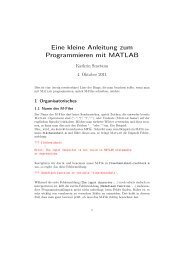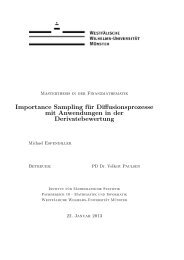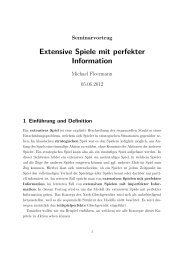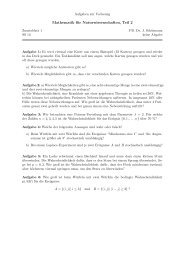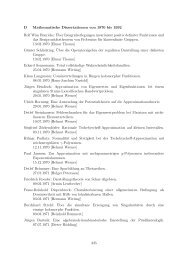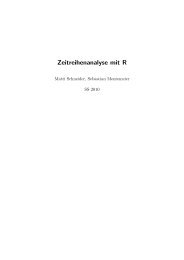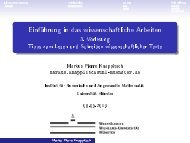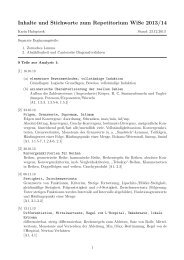Margulis Lemma
Margulis Lemma
Margulis Lemma
You also want an ePaper? Increase the reach of your titles
YUMPU automatically turns print PDFs into web optimized ePapers that Google loves.
STRUCTURE OF FUNDAMENTAL GROUPS 41<br />
with distance < ε/4 to γ(k i ). Thus, they are contained in A j , where j is defined<br />
by p j = γ(k i ). Since their model curves are homotopic modulo N, our rules for<br />
attaching 2-cells imply that γ 0|[ki,k i+1] is homotopic to γ [ki,k i+1] in C.<br />
It remains to check that the homotopy type of γ s does not change at a parameter<br />
s 0 at which s ↦→ γ s is not continuous. By construction there is an i such that<br />
γ s|[0,i−1] and γ s|[i+1,j0] are independent of s ∈ [s 0 − δ, s 0 + δ] for some δ > 0.<br />
The model curve of γ s0−δ|[i−1,i+1] is modulo N homotopic to ˜c s0−δ|[i−1,i+1] which<br />
in turn is homotopic to ˜c s0+δ|[i−1,i+1] and, finally, this curve is modulo N homotopic<br />
to the model curve of γ s0+δ|[i−1,i+1].<br />
Furthermore, the model curves of γ s0±δ|[i−1,i+1] are in an ε/2-neighbourhood of<br />
˜c s0 (i − 1). Since they are homotopic modulo N, this implies by definition of our<br />
complex that γ s0−δ|[i−1,i+1] is homotopic to γ s0+δ|[i−1,i+1] in C .<br />
Thus, the curve γ is homotopic to γ 1 , which is the point curve by construction.<br />
b) Since the number of CW -complexes constructed in a) is finite, we can think<br />
of C as fixed. We choose loops in C 1 representing a free generator system of the<br />
free group π 1 (C 1 , p 1 ). The model curves of these loops represent generators of<br />
π 1 (M, p 1 )/N and the lengths of the loops are bounded.<br />
For each of the attached 2-cells we consider the loop based at some vertex p i in<br />
the one skeleton given by the attaching map. We choose a path in C 1 from p 1 to<br />
p i and conjugate the loop back to π 1 (C 1 , p 1 ).<br />
We can express this loop as word in our free generators and if collect all these<br />
words for all 2-cells, we get a finite presentation of π 1 (C, p 1 ) ∼ = π 1 (M)/N. □<br />
It will be convenient for the proof of Theorem 7 to restate it in a slightly different<br />
form.<br />
Theorem 9.3. a) Given D and n there are finitely many groups F 1 , . . . , F k<br />
such that the following holds: For any compact n-manifold M with Ric ><br />
−(n − 1) and diam(M) ≤ D we can find a nilpotent normal subgroup N ⊳<br />
π 1 (M) which has a nilpotent basis of length ≤ n − 1 such that π 1 (M)/N is<br />
isomorphic to one of the groups in our collection.<br />
b) In addition to a) one can choose a finite collection of irreducible rational<br />
representations ρ j i : F i → GL(n j i , Q) (j = 1, . . . , µ i, i = 1, . . . , k) such that<br />
for a suitable choice of the isomorphism π 1 (M)/N ∼ = F i the following holds:<br />
There is a chain of subgroups Tor(N) = N 0 ⊳ · · · ⊳ N h0 = N which are all<br />
normal in π 1 (M) such that [N, N h ] ⊂ N h−1 and N h /N h−1 is free abelian.<br />
Moroever, the action of π 1 (M) on N by conjugation induces an action of F i<br />
on N h /N h−1 and the induced representation ρ: F i → GL ( (N h /N h−1 ) ⊗ Z Q )<br />
is isomorphic to ρ j i for a suitable j = j(h), h = 1, . . . , h 0.<br />
In addition one can assume in a) that rank(N) ≤ n − 2.<br />
Proof of Theorem 9.3. We consider a contradicting sequence (M i , g i ), that is, we<br />
have diam(M i , g i ) ≤ D and Ric Mi ≥ −(n − 1) but the theorem is not true for any<br />
subsequence of (M i , g i ).<br />
We may assume that diam(M i , g i ) = D and (M i , g i ) converges to some space X.<br />
Choose p i ∈ M i converging to a regular point p ∈ X. By the Gap <strong>Lemma</strong> (2.4)<br />
there is some δ > 0 and ε i → 0 with π 1 (M i , p i , ε i ) = π 1 (M i , p i , δ).<br />
Claim. There is C and i 0 such that π 1 (M i , p i , δ) contains a subgroup of index ≤ C<br />
which has a nilpotent basis of length ≤ n − dim(X) for all large i ≥ i 0 .




